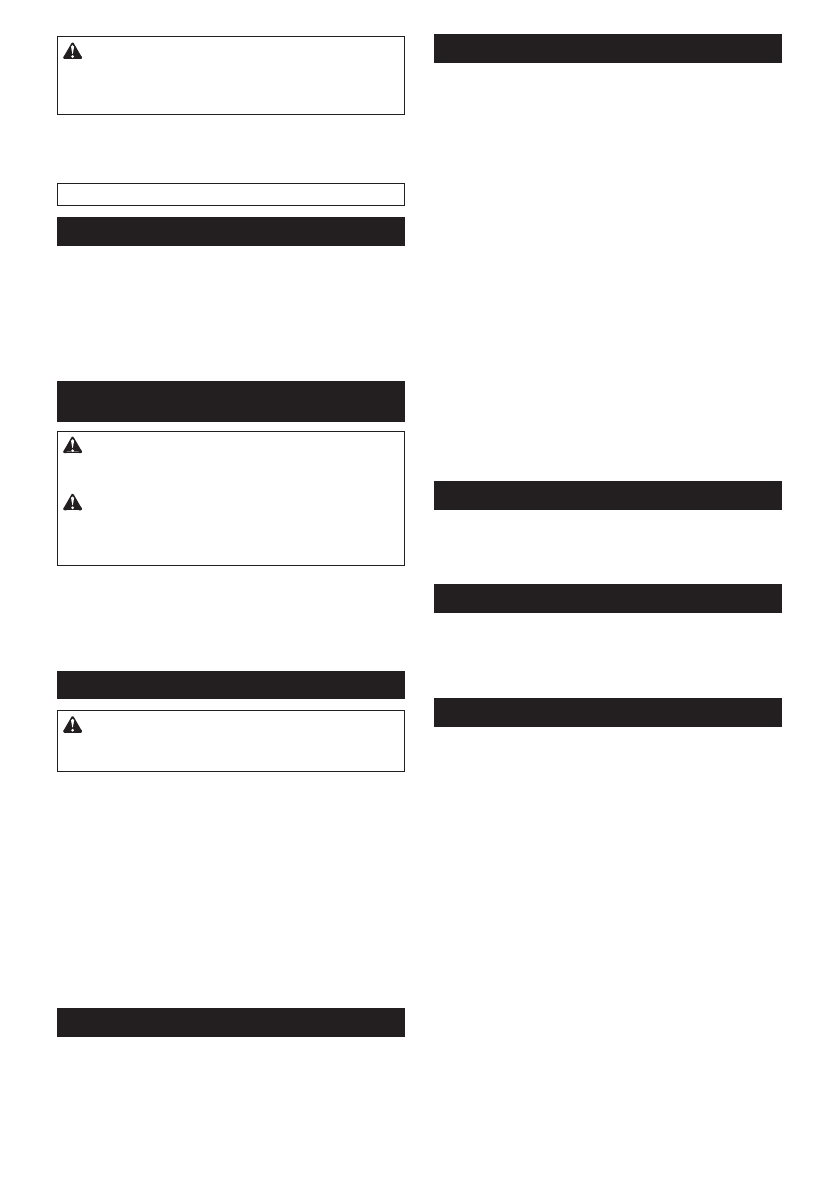Лобзики Makita JV103DZ - инструкция пользователя по применению, эксплуатации и установке на русском языке. Мы надеемся, она поможет вам решить возникшие у вас вопросы при эксплуатации техники.
Если остались вопросы, задайте их в комментариях после инструкции.
"Загружаем инструкцию", означает, что нужно подождать пока файл загрузится и можно будет его читать онлайн. Некоторые инструкции очень большие и время их появления зависит от вашей скорости интернета.

11 ENGLISH
CAUTION:
If the lever does not move to the fixed
position, the blade is not installed completely. Do not
press the lever by hand to the fixed position. It may
damage the tool.
To remove the jig saw blade, push the lever forward as
far as it will go. This allows the blade to be released.
►
Fig.8:
1.
Jig saw blade holder
2.
Jig saw blade
NOTE:
Occasionally lubricate the roller.
Hex wrench storage
►
Fig.9:
1.
Hook
2.
Hex wrench
When not in use, store the hex wrench as shown in the
figure to keep it from being lost.
First, insert the hex wrench into the hole. Then push it
into the hook until it locked.
OPERATION
CAUTION:
Always hold the base flush with
the workpiece.
Failure to do so may cause jig saw
blade breakage, resulting in a serious injury.
CAUTION:
Advance the tool very slowly when
cutting curves or scrolling.
Forcing the tool may
cause a slanted cutting surface and jig saw blade
breakage.
►
Fig.10:
1.
Cutting line
2.
Base
Turn the tool on without the jig saw blade making any
contact and wait until the blade attains full speed. Then
rest the base flat on the workpiece and gently move the
tool forward along the previously marked cutting line.
Bevel cutting
CAUTION:
Always be sure that the tool is
switched off and the battery cartridge is removed
before tilting the base.
With the base tilted, you can make bevel cuts at any
angle between 0° and 45° (left or right).
►
Fig.11
Loosen the bolt on the back of the base with the hex
wrench. Move the base so that the bolt is positioned in
the center of the cross-shaped slot in the base.
►
Fig.12:
1.
Hex wrench
2.
Bolt
3.
Base
Tilt the base until the desired bevel angle is obtained.
The edge of the motor housing indicates the bevel
angle by graduations. Then tighten the bolt to secure
the base.
►
Fig.13:
1.
Edge
2.
Graduation
Front flush cuts
►
Fig.14:
1.
Hex wrench
2.
Bolt
3.
Base
Loosen the bolt on the back of the base with the hex
wrench and slide the base all the way back. Then
tighten the bolt to secure the base.
Cutouts
Cutouts can be made with either of two methods
“Boring a starting hole” or “Plunge cutting”.
Boring a starting hole
►
Fig.15
For internal cutouts without a lead-in cut from an edge,
pre-drill a starting hole 12 mm or more in diameter.
Insert the jig saw blade into this hole to start your cut.
Plunge cutting
►
Fig.16
You need not bore a starting hole or make a lead-in cut
if you carefully do as follows.
1.
Tilt the tool up on the front edge of the base with the jig
saw blade point positioned just above the workpiece surface.
2.
Apply pressure to the tool so that the front edge of
the base will not move when you switch on the tool and
gently lower the back end of the tool slowly.
3.
As the jig saw blade pierces the workpiece, slowly
lower the base of the tool down onto the workpiece surface.
4.
Complete the cut in the normal manner.
Finishing edges
►
Fig.17
To trim edges or make dimensional adjustments, run the
jig saw blade lightly along the cut edges.
Metal cutting
Always use a suitable coolant (cutting oil) when cutting
metal. Failure to do so will cause significant jig saw
blade wear. The underside of the workpiece can be
greased instead of using a coolant.
Dust extraction
Optional accessory
Clean cutting operations can be performed by connect-
ing this tool to a Makita vacuum cleaner.
Installing or removing the dust cover
Install the dust cover as shown in the figure.
►
Fig.18:
1.
Dust cover
To remove the dust cover, press one side of the cover,
and then remove it as shown in the figure.
►
Fig.19:
1.
Dust cover
Installing or removing the dust nozzle
Insert the dust nozzle all the way into the tool.
►
Fig.20:
1.
Dust nozzle
To remove the dust nozzle, pull out the dust nozzle
while pressing the button on the dust nozzle.
►
Fig.21:
1.
Button
2.
Dust nozzle
Connecting the tool to the vacuum cleaner
Connect the hose of the vacuum cleaner to the dust nozzle.
►
Fig.22
Содержание
- 55 ТЕХНИЧЕСКИЕ ХАРАКТЕРИСТИКИ; Назначение; Вибрация
- 56 МЕРЫ БЕЗОПАСНОСТИ; Сохраните брошюру с инструк
- 57 СОХРАНИТЕ ДАННЫЕ; ОПИСАНИЕ РАБОТЫ; Установка или снятие блока
- 58 Защита от перегрева; Выбор действия резки
- 59 Регулятор скорости; Электронная функция; СБОРКА; Установка или снятие полотна
- 60 ЭКСПЛУАТАЦИЯ; Сверление начального отверстия
- 62 ОБСЛУЖИВАНИЕ
Характеристики
Остались вопросы?Не нашли свой ответ в руководстве или возникли другие проблемы? Задайте свой вопрос в форме ниже с подробным описанием вашей ситуации, чтобы другие люди и специалисты смогли дать на него ответ. Если вы знаете как решить проблему другого человека, пожалуйста, подскажите ему :)













































































